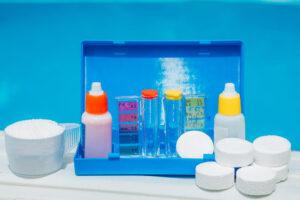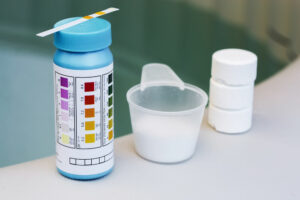Is Pool Shock the Same As Chlorine
If you have a swimming pool or are interested in pool maintenance, you might have come across these terms. While they are related, pool shock and chlorine are not exactly the same things.
In this article, we will break down the differences and similarities between pool shock and chlorine in a simple and easy-to-understand manner. We will discuss their composition, usage, effects on water disinfection and clarity, dosage recommendations, and more.
By the end, you’ll have a clear understanding of how pool shock and chlorine play distinct roles in keeping your pool safe and enjoyable. So, let’s dive in and unravel the mysteries of pool shock and chlorine!
Understanding Pool Shock and Chlorine: Exploring the Differences and Similarities

Pool shock and chlorine are both commonly used in swimming pool maintenance, but they are not exactly the same thing. To understand their differences and similarities, it’s essential to delve into their properties and functions.
Defining Pool Shock: What It Is and How It Differs from Chlorine
Pool shock refers to a highly concentrated form of chlorine typically used for treating various water-related issues in pools, such as algae growth, cloudy water, and bacterial contamination. It is usually sold as a granular substance or powder.
Chlorine, on the other hand, is a chemical element (Cl) commonly used as a disinfectant in pool water. While pool shock contains chlorine, it is not synonymous with chlorine itself.
The Chemistry Behind Pool Shock and Chlorine: A Comparative Analysis

Pool shock usually contains a higher concentration of chlorine than traditional chlorine products. The active ingredient in pool shock is often calcium hypochlorite or sodium dichloroisocyanurate (SDIC).
These compounds break down in water to release hypochlorous acid, which acts as a powerful oxidizer and sanitizer. Chlorine, as a chemical element, exists in various forms such as chlorine gas, liquid chlorine (sodium hypochlorite), and chlorine tablets (trichloroisocyanuric acid or dichloroisocyanuric acid).
These different forms have varying compositions and react differently in water.
Pool Shock vs. Chlorine: Examining Their Composition and Chemical Makeup
The composition of pool shock and chlorine differs in terms of concentration and additional chemicals. Pool shock often contains 65-75% available chlorine, while traditional chlorine products like liquid chlorine or chlorine tablets typically have lower concentrations, ranging from 1% to 12%.
Additionally, pool shock may contain additives such as stabilizers, pH adjusters, or clarifiers to enhance its effectiveness and address specific pool maintenance needs.
Pool Shock and Chlorine: Different Forms and Applications in Pool Maintenance

While chlorine is available in various forms, such as gas, liquid, and tablets, pool shock is primarily sold as a granular substance or powder.
The different forms of chlorine are utilized differently in pool maintenance. Gas chlorine is usually added through specialized equipment, liquid chlorine can be poured directly into the pool, and chlorine tablets are commonly used in floating dispensers or automatic chlorinators.
Pool shock is typically broadcasted over the pool surface or added directly to the skimmer.
Pool Shock and Chlorine: Comparative Effects on Water Disinfection
Both pool shock and chlorine effectively disinfect pool water by killing bacteria, viruses, and other harmful microorganisms.
However, due to its higher concentration, pool shock can provide a more rapid and powerful disinfecting effect. It is often used in cases where pool water requires intensive treatment, such as after heavy rainfall, at a pool party, or when dealing with persistent algae blooms.
Traditional chlorine products are generally used for regular maintenance and maintaining proper disinfection levels.
Pool Shock and Chlorine: Contrasting Usage and Dosage Recommendations
The usage and dosage recommendations for pool shock and chlorine vary. Pool shock is typically applied periodically or as needed, depending on specific pool conditions.
It is commonly used as a shock treatment to eliminate contaminants or restore water clarity. Chlorine, on the other hand, is added regularly to maintain a consistent residual disinfectant level in the pool.
The dosage of chlorine depends on factors such as pool size, water temperature, bather load, and sunlight exposure.
Pool Shock and Chlorine: Impact on Water Clarity and Algae Control
Both pool shock and chlorine contribute to water clarity and help control algae growth. Pool shock’s high chlorine concentration and oxidizing properties effectively destroy algae cells and break down organic matter that can cause water cloudiness.
Traditional chlorine products also inhibit algae growth but may require higher concentrations or additional algaecides for effective control.
Proper maintenance and regular monitoring of chlorine levels are crucial to prevent algae growth and maintaining crystal-clear water.
Pool Shock vs. Chlorine Tablets: Choosing the Right Option for Your Pool

When selecting between pool shock and chlorine tablets, several factors come into play. Pool shock is ideal for treating specific issues, such as severe algae blooms or excessive organic contamination.
It provides a quick and concentrated solution for such problems. Chlorine tablets, on the other hand, offer convenience and continuous disinfection.
They are often used in automatic chlorinators or floating dispensers, slowly dissolving over time to maintain a consistent chlorine level.
The Role of Pool Shock and Chlorine in Maintaining a Healthy Swimming Environment
Both pool shock and chlorine play vital roles in maintaining a healthy swimming environment. They work together to kill harmful microorganisms, control algae growth, and provide safe and clear pool water for swimmers.
Regular monitoring of chlorine levels, appropriate shock treatments when needed, and proper maintenance practices are essential to ensure a healthy and enjoyable swimming experience while minimizing the risk of waterborne illnesses.
Here’s a comparison table highlighting the key differences between pool shock and chlorine:
| Pool Shock | Chlorine | |
| Composition | Contains a higher concentration of chlorine | Available in various forms such as gas, liquid, and tablets |
| Form | Granular substance or powder | Gas, liquid, or tablets |
| Usage | Applied periodically or as needed for specific issues | Added regularly for consistent disinfection |
| Disinfection | Provides rapid and powerful disinfection | Provides regular maintenance of disinfection levels |
| Water Clarity | Helps eliminate contaminants and restore water clarity | Controls algae growth and maintains water clarity |
| Dosage | Dependent on specific pool conditions and requirements | Varies based on pool size, water temperature, and bather load |
| Algae Control | Effective in treating severe algae blooms | Requires higher concentrations or additional algaecides |
| Convenience | Used for targeted treatments | Provides continuous disinfection |
| Application | Broadcasted over the pool surface or added to the skimmer | Added through equipment, poured directly, or used in tablets |
| Additional Additives | May contain stabilizers, pH adjusters, or clarifiers | May contain stabilizers or other additives for convenience |

It’s important to note that the specific details and characteristics of pool shock and chlorine may vary depending on the brand and product. Always follow the manufacturer’s instructions and guidelines for proper usage and dosage recommendations.
In conclusion,
we have learned that while pool shock and chlorine are related, they are not the same thing. Pool shock is a concentrated form of chlorine used for specific treatments, while chlorine comes in various forms and is used for regular disinfection.
Pool shock provides rapid and powerful disinfection, helps restore water clarity, and is effective against severe algae blooms.
Chlorine, on the other hand, ensures continuous disinfection, controls algae growth, and maintains water clarity. Understanding the differences between pool shock and chlorine is essential for proper pool maintenance.
By following dosage recommendations and practicing regular monitoring, you can create a healthy and enjoyable swimming environment for all.
So, keep these insights in mind as you take care of your pool and enjoy the refreshing water with peace of mind.














